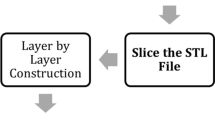Abstract
Among all technologies applied in three-dimensional printing (3DP), fused deposition modeling (FDM) is the most developing one because it is capable of producing parts with geometrically complex figures. Despite its wide applications, there are some drawbacks to its extension, for instance, weak mechanical characteristics and low dimensional accuracy. In this paper, the influence of four FDM process parameters (layer height, printing speed, infill density, and the number of top and bottom layers) on four criteria (impact strength, dimensional accuracy, consumed raw material, and production time) of polylactic acid (PLA) parts is studied. Unlike previous research, this research not only optimizes the properties of produced parts but also minimizes production costs. First, each criterion is analyzed singly; then, in an investigation, all criteria are combined and optimized simultaneously. In other words, a comprehensive decision is made considering both products' qualities and the production costs. The applied methodology for multi-criterion decision-making in this research is also usable in other fields of industry. With the help of this methodology, the best selection of process parameters' levels is attainable. According to the results, layer height = 0.3 mm, number of top and bottom layers = 2, infill density = 60% and print speed = 45.28 mm/s are the best choice while considering all four criteria. Layer height is found the most effective parameter. An increase in layer height leads to a stronger part with a shorter production time but a heavier one with less dimensional accuracy.











Similar content being viewed by others
References
Syrlybayev, D.; Zharylkassyn, B.; Seisekulova, A.; Akhmetov, M.; Perveen, A.; Talamona, D.: Optimisation of strength properties of FDM printed parts—a critical review. Polymers 13(10), 1587 (2021)
Dey, A.; Yodo, N.: A systematic survey of FDM process parameter optimization and their influence on part characteristics. J. Manuf. Mater. Process. 3(3), 64 (2019)
Mohan, N.; Senthil, P.; Vinodh, S.; Jayanth, N.: A review on composite materials and process parameters optimisation for the fused deposition modelling process. Virtual Phys. Prototyp. 12(1), 47–59 (2017)
Liu, Z.; Wang, Y.; Wu, B.; Cui, C.; Guo, Y.; Yan, C.: A critical review of fused deposition modeling 3D printing technology in manufacturing polylactic acid parts. Int. J. Adv. Manuf. Technol. 102(9), 2877–2889 (2019)
Eynde, M.V.D.; Puyvelde, P.V.: 3D Printing of Poly (lactic acid). In: Industrial Applications of Poly (Lactic Acid), pp. 139–158 (2017)
Gordelier, T.J.; Thies, P.R.; Turner, L.; Johanning, L.: Optimising the FDM additive manufacturing process to achieve maximum tensile strength: A state-of-the-art review. Rapid Prototyping J. 25, 953–971 (2019)
Popescu, D.; Zapciu, A.; Amza, C.; Baciu, F.; Marinescu, R.: FDM process parameters influence over the mechanical properties of polymer specimens: a review. Polym. Testing 69, 157–166 (2018)
Liu, X., et al.: Mechanical property parametric appraisal of fused deposition modeling parts based on the Gray Taguchi method. Int. J. Adv. Manuf. Technol. 89(5–8), 2387–2397 (2017). https://doi.org/10.1007/s00170-016-9263-3
Chandrashekarappa, M.P.G.; Chate, G.R.; Parashivamurthy, V.; Kumar, B.S.; Bandukwala, M.A.N.; Kaisar, A.; Giasin, K.; Pimenov, D.Y.; Wojciechowski, S.: Analysis and optimization of dimensional accuracy and porosity of high impact polystyrene material printed by FDM process: PSO, JAYA, Rao, and Bald Eagle Search Algorithms. Materials 14(23), 7479 (2021)
Mohamed, O.A.; Masood, S.H.; Bhowmik, J.L.: Modeling, analysis, and optimization of dimensional accuracy of FDM-fabricated parts using definitive screening design and deep learning feedforward artificial neural network. Adv. Manuf. 9(1), 115–129 (2021)
Atakok, G.; Kam, M.; Koc, H.B.: A Review of mechanical and thermal properties of products printed with recycled filaments for use in 3d printers. Surf. Rev. Lett. 29(02), 2230002 (2022)
Atakok, G.; Kam, M.; Koc, H.B.: Tensile, three-point bending and impact strength of 3D printed parts using PLA and recycled PLA filaments: a statistical investigation. J. Market. Res. 18, 1542–1554 (2022)
Çevik, Ü., Kam, M.: A review study on mechanical properties of obtained products by FDM method and metal/polymer composite filament production. J. Nanomater. 2020, 1–9 (2020)
Kam, M.; İpekçi, A.; Şengül, Ö.: Investigation of the effect of FDM process parameters on mechanical properties of 3D printed PA12 samples using Taguchi method. J. Thermoplast. Compos. Mater. 36(1), 307–325 (2023)
Kam, M.; Ipekci, A.; Sengul, O.: Taguchi optimization of fused deposition modeling process parameters on mechanical characteristics of PLA+ filament material. Scientia Iranica 29(1), 79–89 (2022)
Montgomery, D.C.: Design and Analysis of Experiments. Wiley, New York (2017)
Cochran, W.G.; Cox, G.M.: Experimental Designs, 2nd edn. Wiley, New York (1957)
Li, X.; Sudarsanam, N.; Frey, D.D.: Regularities in data from factorial experiments. Complexity 11(5), 32–45 (2006)
Bergquist, B.; Vanhatalo, E.; Nordenvaad, M.L.: A Bayesian analysis of unreplicated two-level factorials using effects sparsity, hierarchy, and heredity. Qual. Eng. 23(2), 152–166 (2011)
Taha, H.A.: Operation Research: An Introduction, 7th edn. Pearson Education, Singapore (2003)
Bazaraa, M.S.; Jarvis, J.J.; Sherali, H.D.: Linear Programming and Network Flows. Wiley, New York (2008)
Author information
Authors and Affiliations
Corresponding author
Rights and permissions
Springer Nature or its licensor (e.g. a society or other partner) holds exclusive rights to this article under a publishing agreement with the author(s) or other rightsholder(s); author self-archiving of the accepted manuscript version of this article is solely governed by the terms of such publishing agreement and applicable law.
About this article
Cite this article
Solouki, A., Aliha, M. & Makui, A. A Methodology for Optimizing Impact Strength, Dimensional Accuracy and Costs of Manufacturing with Three-Dimensional Printing of Polylactic Acid. Arab J Sci Eng 49, 7545–7569 (2024). https://doi.org/10.1007/s13369-023-08422-3
Received:
Accepted:
Published:
Issue Date:
DOI: https://doi.org/10.1007/s13369-023-08422-3




